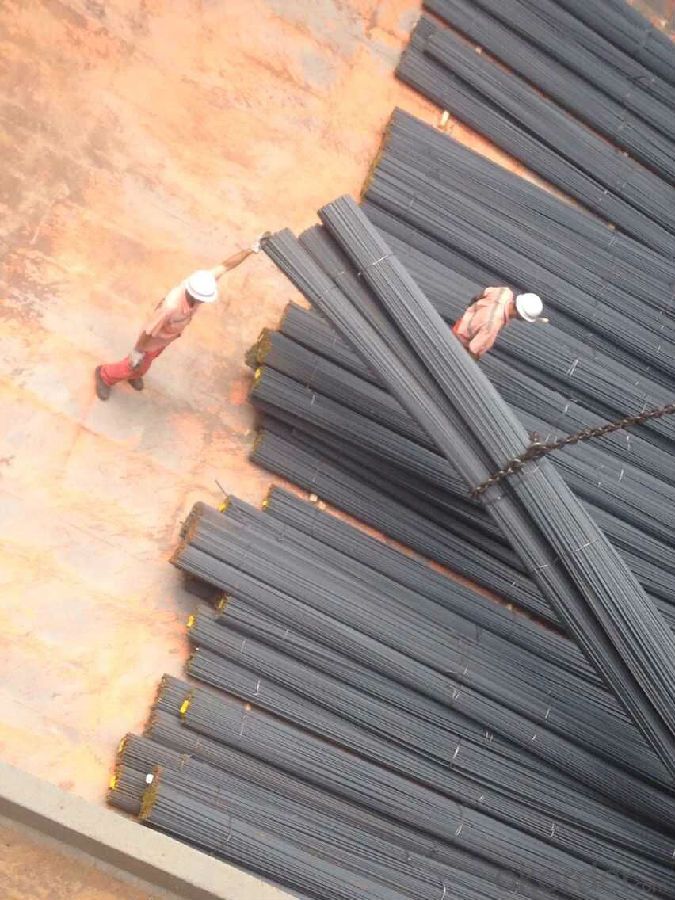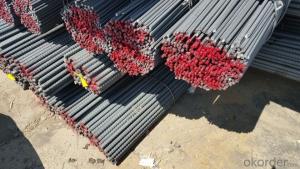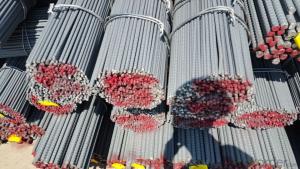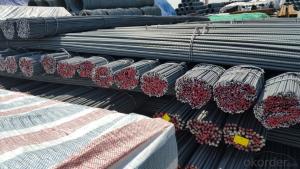Deformed Rebars for Reinforcing Concrete
- Loading Port:
- China main port
- Payment Terms:
- TT OR LC
- Min Order Qty:
- 100 m.t.
- Supply Capability:
- 10000 m.t./month
OKorder Service Pledge
OKorder Financial Service
You Might Also Like
Product Description:
OKorder is offering Deformed Rebars for Reinforcing Concrete at great prices with worldwide shipping. Our supplier is a world-class manufacturer of steel, with our products utilized the world over. OKorder annually supplies products to African, South American and Asian markets. We provide quotations within 24 hours of receiving an inquiry and guarantee competitive prices.
Product Applications:
Deformed Rebars for Reinforcing Concrete are ideal for structural applications and are widely used in the construction of buildings and bridges, and the manufacturing, petrochemical, and transportation industries.
Product Advantages:
OKorder's Deformed Rebars for Reinforcing Concrete are durable, strong, and wide variety of sizes.
Main Product Features:
· Premium quality
· Prompt delivery & seaworthy packing (30 days after receiving deposit)
· Can be recycled and reused
· Mill test certification
· Professional Service
· Competitive pricing
Product Specifications:
Manufacture: Hot rolled
Grade: HRB335,HRB400,HRB500
Certificates: ISO, SGS, BV, CIQ
Length: 6m – 12m, as per customer request
Packaging: Export packing, nude packing, bundled
Deformed Steel Bar | ||
Diameter (MM) | Cross Sectional Area (MM2) | Theorectical Weight (KG/M) |
6 | 28.27 | 0.222 |
8 | 50.27 | 0.395 |
10 | 78.54 | 0.617 |
12 | 113.1 | 0.888 |
14 | 153.9 | 1.21 |
16 | 201.1 | 1.58 |
18 | 254.5 | 2 |
20 | 314.2 | 2.47 |
22 | 380.1 | 2.98 |
25 | 490.9 | 3.85 |
28 | 615.8 | 4.83 |
32 | 804.2 | 6.31 |
36 | 1018 | 7.99 |
40 | 1257 | 9.87 |
FAQ:
Q1: How many tons of steel products could be loaded in containers?
A1: Usually the steel products are delivered by bulk vessel because of the large quantity and the freight. However, there are no bulk vessel enter some seaports so that we have to deliver the cargo by containers. The 6m steel product can be loaded in 20FT container, but the quantity is changed according to the size, usually from 18tons to 25tons.
Q2: How soon can we receive the product after purchase?
A2: Within three days of placing an order, we will arrange production. The normal sizes with the normal grade can be produced within one month. The specific shipping date is dependent upon international and government factors, the delivery to international main port about 45-60days.
Q3: How do we guarantee the quality of our products?
A3: We have established an advanced quality management system which conducts strict quality tests at every step, from raw materials to the final product. At the same time, we provide extensive follow-up service assurances as required.
Images:


- Q:What is the role of steel rebars in minimizing the risk of concrete spalling due to sulfate attack?
- Steel rebars play a crucial role in minimizing the risk of concrete spalling due to sulfate attack by providing reinforcement and increasing the overall strength of the concrete structure. When concrete is exposed to sulfate ions, it can undergo a chemical reaction that leads to expansion and cracking, resulting in spalling. However, steel rebars act as a reinforcement, helping to distribute the stress and load throughout the concrete, reducing the risk of cracking and spalling. Additionally, the presence of rebars helps to maintain the structural integrity of the concrete, preventing the ingress of sulfate ions and minimizing the potential for sulfate attack.
- Q:What's the difference between rebar and thread steel?
- Physical and mechanical properties are different. Because of the different chemical composition and strength of reinforcing steel, they are different in physical and mechanical properties. The cold bending property of steel is good, can make the hook 180, screw steel can only make straight hook 90 degrees; steel weldability is good, with ordinary carbon steel electrode can be used to low alloy electrode; anti fatigue performance and toughness in steel bar is good.
- Q:Can steel rebars be used in road construction projects?
- Yes, steel rebars can be used in road construction projects. Steel rebars are commonly used as reinforcement in concrete structures, including roads. They help to increase the overall strength and durability of the road by reinforcing the concrete. The rebars are typically placed within the concrete pavement to provide tensile strength and prevent cracking or breaking under heavy loads. Additionally, steel rebars are corrosion-resistant, which is essential for road construction projects where exposure to moisture and harsh weather conditions is common. Overall, using steel rebars in road construction projects enhances the structural integrity and longevity of the road.
- Q:How do steel rebars affect the acoustic properties of a structure?
- Steel rebars can have a significant impact on the acoustic properties of a structure. Due to their high density and rigidity, steel rebars can act as conductors of sound and vibrations. This means that when sound waves or vibrations encounter steel rebars, they can easily be transmitted through them, resulting in increased noise levels and reduced acoustic insulation. In terms of airborne sound transmission, steel rebars can create a direct pathway for sound waves to travel through a structure. This can lead to the amplification of sound, especially in areas where rebars are in direct contact with walls or floors. As a result, the overall acoustic quality of the structure may be compromised, causing increased noise levels and decreased speech intelligibility. Steel rebars can also affect the structure's ability to block impact or structure-borne noise. When vibrations are generated, for example, from footsteps or machinery, the rigid steel rebars can efficiently transmit these vibrations throughout the structure. This can result in the amplification and propagation of structure-borne noise, making it more perceptible in different areas of the building. To mitigate the negative effects of steel rebars on the acoustic properties of a structure, various techniques can be employed. One common method is to use acoustically decoupled materials or resilient mounts to isolate the rebars from the surrounding structure, reducing the transmission of vibrations. Additionally, incorporating sound-absorbing materials, such as acoustic panels or insulation, can help to absorb and dampen sound waves, improving the overall acoustic performance of the space. Overall, steel rebars can have a significant impact on the acoustic properties of a structure. Their high density and rigidity make them efficient conductors of sound and vibrations, potentially leading to increased noise levels and reduced acoustic insulation. Therefore, careful consideration of acoustic design and appropriate use of soundproofing measures are essential in minimizing the adverse effects of steel rebars on the acoustic quality of a building.
- Q:What are the guidelines for cutting and bending steel rebars on-site?
- When it comes to cutting and bending steel rebars on-site, there are several guidelines that should be followed to ensure safety and accuracy. These guidelines are important to ensure that the rebars are cut and bent correctly, without compromising their structural integrity. Here are some key guidelines to consider: 1. Safety precautions: Before starting any cutting or bending activities, it is crucial to prioritize safety. This includes wearing appropriate personal protective equipment (PPE) such as goggles, gloves, and steel-toe boots. Additionally, ensure that the work area is clear of any hazards and that proper safety protocols are followed. 2. Cutting the steel rebars: When cutting rebars, use a high-quality cutting tool that is specifically designed for this purpose. Manual cutting tools like bolt cutters or hydraulic shears are commonly used. Make sure the cutting tool is sharp and in good condition to ensure clean cuts. Avoid using torches or heat-based methods as they can weaken the rebars. 3. Measuring and marking: Before cutting, carefully measure and mark the rebars according to the required lengths. Use a measuring tape and a permanent marker to ensure accuracy. Double-check the measurements to avoid any mistakes that could lead to wastage or improper reinforcement. 4. Bending the steel rebars: When bending rebars, it is important to use a proper bending tool or machine. These tools ensure accurate bending angles and minimize the risk of rebars breaking or cracking. Follow the bending specifications provided by the project engineer or adhere to the local building codes to ensure compliance. 5. Reinforcement requirements: Familiarize yourself with the project plans, drawings, and specifications to understand the reinforcement requirements. Different projects may have specific guidelines for cutting and bending rebars. It is crucial to follow these requirements to ensure the rebars are correctly installed and provide the necessary structural strength. 6. Quality control: Regularly inspect the rebars during the cutting and bending process to ensure they meet the required standards. Look for any signs of damage, cracks, or subpar workmanship. Additionally, make sure the rebars are properly sorted and stored to prevent any potential mix-ups or confusion on-site. 7. Waste management: Properly manage the waste generated during the cutting and bending process. Collect and dispose of any steel shavings or offcuts in designated containers to prevent injuries or accidents caused by the sharp edges. Overall, following these guidelines for cutting and bending steel rebars on-site will help ensure the safety, accuracy, and effectiveness of the reinforcement process. It is important to consult with experienced professionals or consult the project engineer if there are any uncertainties or specific requirements for a particular project.
- Q:Can steel rebars be used in energy-efficient buildings?
- Certainly! Energy-efficient buildings can indeed incorporate steel rebars. These rebars are commonly utilized in the construction of reinforced concrete structures, including those that prioritize energy efficiency. Energy-efficient buildings aim to decrease energy consumption and minimize their environmental footprint. Although steel is a material with high embodied energy, meaning it requires a substantial amount of energy for production, it boasts numerous advantages for energy-efficient buildings. To begin with, steel rebars lend structural strength to reinforced concrete, enabling the creation of robust and long-lasting structures. This is pivotal for energy-efficient buildings, as their goal is to have an extended lifespan and reduced maintenance requirements, thereby lessening their overall environmental impact. Additionally, steel rebars can be employed in the construction of energy-efficient building components, such as insulated concrete forms (ICFs) and precast concrete panels. These building systems possess exceptional thermal insulation properties, which decrease heat transfer and enhance energy efficiency. Steel rebars are utilized to reinforce these components, ensuring their structural integrity. Furthermore, the thermal mass characteristics of concrete, reinforced by steel rebars, can contribute to a building's energy efficiency. Concrete has the capability to absorb and store heat, aiding in the regulation of indoor temperatures and reducing the need for excessive heating or cooling. Consequently, this can result in significant energy savings throughout a building's lifespan. It is important to note that the energy efficiency of a building is contingent upon various factors, including insulation, window design, HVAC systems, and the integration of renewable energy. While steel rebars play a vital role in reinforced concrete structures, their impact on overall energy efficiency should be evaluated in conjunction with other design choices and building materials.
- Q:How do steel rebars improve the structural integrity of a building?
- Steel rebars improve the structural integrity of a building by reinforcing concrete structures, providing additional strength and stability. The rebars act as a skeleton within the concrete, distributing and transferring loads more effectively, preventing cracks and reducing the risk of collapse.
- Q:What are the guidelines for spacing and positioning steel rebars in concrete structures?
- The guidelines for spacing and positioning steel rebars in concrete structures are critical to ensure the structural integrity and durability of the construction. Here are some key guidelines to follow: 1. Rebar Spacing: The spacing between steel rebars in concrete structures is determined by the structural engineer or designer. It is typically expressed in terms of center-to-center spacing or clear distance between rebars. The spacing depends on the load requirements, concrete strength, and other factors specific to the project. The most common spacing ranges from 4 to 12 inches. 2. Cover Depth: The concrete cover depth refers to the distance between the outer surface of the concrete and the nearest surface of the rebar. It is essential to provide adequate cover to protect the rebars from environmental factors, such as corrosion and fire. The cover depth is typically specified in the project's design and can vary depending on the concrete's exposure conditions. 3. Rebar Positioning: The proper positioning of rebars is crucial to ensure they are placed in the designated locations within the concrete structure. The rebars should be securely supported and maintained in the correct alignment during the concrete pouring process. The positioning requirements may include specific lap lengths, overlaps, or hooking of rebars at junctions to ensure proper load transfer and structural continuity. 4. Chair Supports: Rebar chair supports are widely used to maintain the correct spacing and elevation of the rebars within the concrete structure. These supports are placed under the rebars at regular intervals to prevent sagging or displacement during concrete placement. The appropriate chair support type and height should be selected based on the project's requirements and the diameter of the rebars. 5. Tying and Binding: Proper tying and binding of rebars are essential to ensure they remain in position and maintain the required spacing during the concrete pouring process. Rebars should be tied securely using wire or rebar ties at appropriate intervals, typically every 12-18 inches. The ties should be tight enough to prevent movement but not overly tight to avoid damaging the rebars or causing concrete segregation. 6. Concrete Consolidation: During concrete placement, it is crucial to properly consolidate the concrete around the rebars to eliminate air voids and ensure adequate bonding between the concrete and the rebars. Vibrators or other consolidation techniques should be used to achieve proper compaction and ensure the rebars are thoroughly embedded in the concrete. Compliance with the guidelines for spacing and positioning steel rebars in concrete structures is essential to guarantee the structural strength, durability, and safety of the construction. It is crucial to consult and follow the project's design specifications and engage qualified professionals to ensure proper execution and adherence to these guidelines.
- Q:What are the common problems associated with steel rebars in construction?
- Steel rebars in construction can pose several common problems. One of the primary concerns is corrosion, as moisture and oxygen can cause rusting, particularly in humid or coastal areas. This rusting weakens the rebars and compromises the structure's integrity. Improper installation is another issue. If rebars are not correctly positioned or adequately secured, they fail to provide the necessary reinforcement and support, leading to safety hazards and structural failures. Concerns also arise regarding the size and spacing of rebars. Inadequate distribution of loads or poor resistance to bending and cracking can occur if the rebars are too small or spaced too far apart. Conversely, if the rebars are too large or closely placed, construction costs increase, and the concrete mix becomes difficult to work with. Poor bonding between the rebar and the concrete poses another challenge. Inadequate contact or bonding between these materials compromises the structure's integrity and reduces the load-bearing capacity of the reinforced concrete. Lastly, the quality of the steel rebars themselves can be problematic. Defects such as impurities or inconsistencies in composition weaken the reinforcement and compromise the overall strength of the structure. To address these issues, it is crucial to use high-quality rebars, adhere to proper installation techniques, and ensure maintenance and protection against corrosion. Regular inspections and testing aid in identifying problems and ensuring the longevity and safety of the reinforced concrete structure.
- Q:What are the guidelines for the proper storage of steel rebars on construction sites?
- Ensuring the integrity and safety of steel rebars on construction sites is of utmost importance. To achieve this, the following recommendations should be followed: 1. It is crucial to select a suitable storage area for steel rebars. This entails choosing a flat, stable, and well-drained location, while avoiding areas that are prone to flooding or excessive moisture. 2. Ample space should be provided between rebars to prevent any contact or entanglement that could potentially cause damage. Additionally, clear aisles and pathways should be maintained to facilitate easy access and movement. 3. The protection of steel rebars against corrosion is essential. To achieve this, they should be covered with waterproof and UV-resistant tarpaulins or plastic sheets. This shielding will safeguard the rebars from rain, snow, or direct sunlight. 4. To prevent contact with water, dirt, or other contaminants that can accelerate corrosion, it is imperative to elevate the rebars from the ground. This can be accomplished by placing them on wooden supports or pallets. 5. When stacking rebars, it is important to ensure stability and prevent rolling or falling. Larger and heavier rebars should be positioned at the bottom of the stack to create a secure foundation. 6. Each stack should be clearly labeled with information such as size, length, and grade. This will facilitate easy identification. Furthermore, separating different sizes or types of rebars in the storage area will minimize confusion and aid in retrieval. 7. Regular inspections should be conducted to check for signs of corrosion, damage, or deformation. Any rebars showing signs of deterioration should be promptly removed to prevent accidents or compromised structural integrity. 8. When moving or transporting rebars, appropriate lifting equipment such as cranes, forklifts, or hoists should be used. Avoiding dragging or dropping the rebars is crucial, as it can cause deformation or damage. 9. It is vital to consult the manufacturer's guidelines for specific storage requirements and recommended practices pertaining to the particular type of steel rebars being used. By adhering to these guidelines, construction sites can ensure the proper storage of steel rebars. This, in turn, will help maintain their quality, prolong their lifespan, and guarantee the safety of both workers and structures.
1. Manufacturer Overview |
|
|---|---|
| Location | |
| Year Established | |
| Annual Output Value | |
| Main Markets | |
| Company Certifications | |
2. Manufacturer Certificates |
|
|---|---|
| a) Certification Name | |
| Range | |
| Reference | |
| Validity Period | |
3. Manufacturer Capability |
|
|---|---|
| a)Trade Capacity | |
| Nearest Port | |
| Export Percentage | |
| No.of Employees in Trade Department | |
| Language Spoken: | |
| b)Factory Information | |
| Factory Size: | |
| No. of Production Lines | |
| Contract Manufacturing | |
| Product Price Range | |
Send your message to us
Deformed Rebars for Reinforcing Concrete
- Loading Port:
- China main port
- Payment Terms:
- TT OR LC
- Min Order Qty:
- 100 m.t.
- Supply Capability:
- 10000 m.t./month
OKorder Service Pledge
OKorder Financial Service
Similar products
New products
Hot products
Related keywords




























